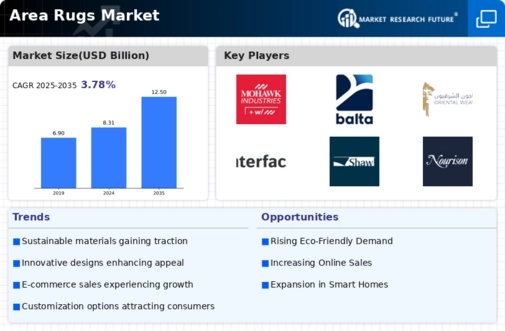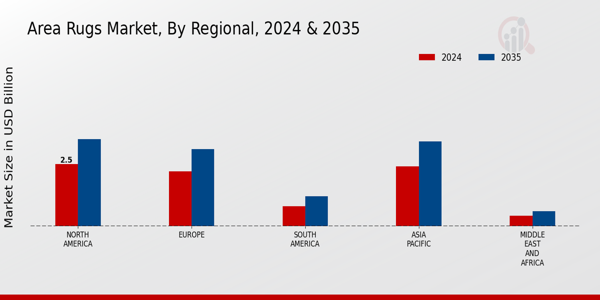Rising Home Decor Trends
The Global Area Rugs Market Industry experiences a notable surge due to the increasing emphasis on home decor. As consumers seek to enhance their living spaces, area rugs serve as essential decorative elements that add warmth and style. In 2024, the market is projected to reach 8.31 USD Billion, reflecting a growing preference for aesthetically pleasing interiors. This trend is particularly evident in urban areas where space optimization is crucial, leading to a demand for versatile and stylish rugs. The integration of area rugs into modern design schemes indicates a shift towards personalized home environments, driving market growth.
Market Growth Projections
The Global Area Rugs Market Industry is poised for substantial growth, with projections indicating a market size of 8.31 USD Billion in 2024 and an anticipated increase to 12.5 USD Billion by 2035. This growth trajectory reflects a compound annual growth rate (CAGR) of 3.78% from 2025 to 2035. Factors contributing to this expansion include rising disposable incomes, increased urbanization, and a growing interest in home improvement projects. As consumers invest more in their living spaces, the demand for area rugs is expected to rise, further solidifying the industry's position in the global market.
Diverse Consumer Preferences
Diverse consumer preferences significantly impact the Global Area Rugs Market Industry, as buyers seek rugs that reflect their unique tastes and lifestyles. The market caters to a wide array of styles, from traditional to contemporary, allowing consumers to find products that resonate with their personal aesthetics. This diversity in preferences drives innovation among manufacturers, who are compelled to create varied designs and materials to meet evolving demands. As the market continues to adapt to these changing consumer behaviors, it is likely to experience steady growth, with a projected CAGR of 3.78% from 2025 to 2035, indicating a robust future for the industry.
Growing E-Commerce Platforms
The proliferation of e-commerce platforms plays a crucial role in shaping the Global Area Rugs Market Industry. As online shopping becomes increasingly popular, consumers are more inclined to purchase area rugs through digital channels. This shift is driven by the convenience of browsing extensive collections and the ability to compare prices easily. E-commerce platforms also facilitate access to a wider range of products, including niche and artisanal rugs that may not be available in traditional retail settings. This trend is expected to bolster market growth, as online sales channels continue to expand, providing manufacturers with new opportunities to reach diverse consumer segments.
Sustainability and Eco-Friendly Products
Sustainability emerges as a pivotal driver in the Global Area Rugs Market Industry, with consumers increasingly favoring eco-friendly products. The demand for rugs made from natural fibers and sustainable materials is on the rise, as environmentally conscious buyers seek to minimize their ecological footprint. This trend is supported by various initiatives promoting sustainable manufacturing practices. As a result, manufacturers are adapting their offerings to include organic and recycled materials, appealing to a broader audience. This shift not only enhances brand loyalty but also positions companies favorably in a competitive market, potentially contributing to the projected growth of the industry.
Technological Advancements in Production
Technological advancements significantly influence the Global Area Rugs Market Industry by enhancing production efficiency and design capabilities. Innovations such as automated weaving and digital printing allow manufacturers to create intricate designs and patterns that cater to diverse consumer preferences. This technological evolution not only reduces production costs but also enables quicker turnaround times, meeting the increasing demand for customized rugs. As the industry adapts to these advancements, it is likely to witness sustained growth, with projections indicating a market size of 12.5 USD Billion by 2035. The ability to offer unique, high-quality products positions companies competitively in the evolving market landscape.








